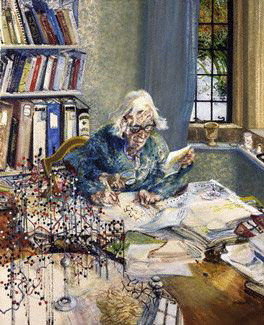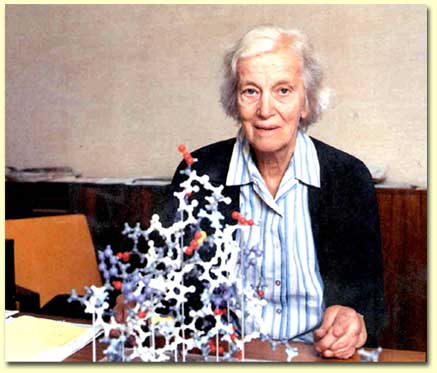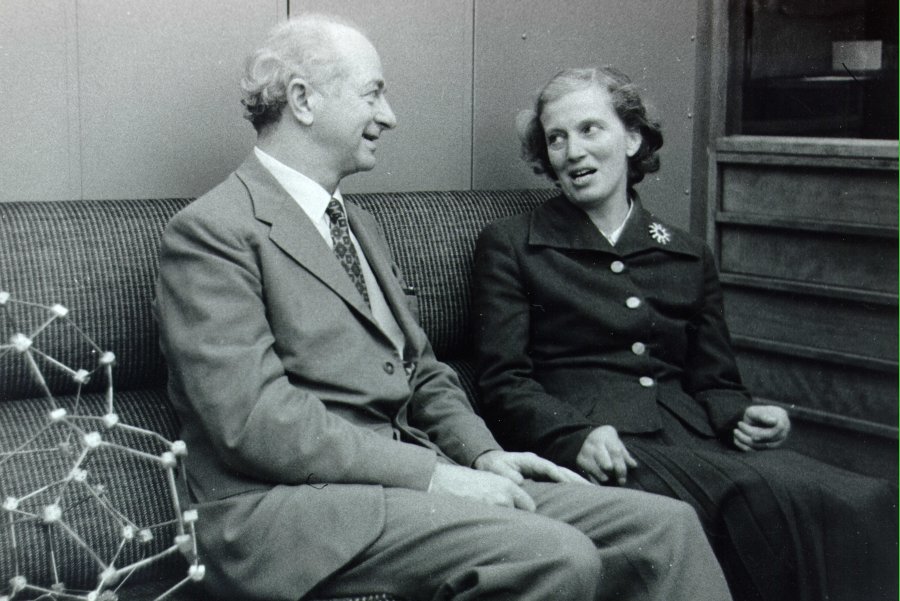<Back to Index>
- Chemist Dorothy Mary Hodgkin, 1910
- Poet and Painter Dante Gabriel Rossetti, 1828
- King of Poland Augustus II the Strong, 1670
PAGE SPONSOR

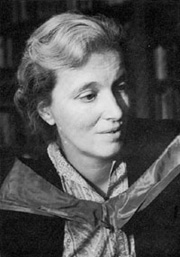
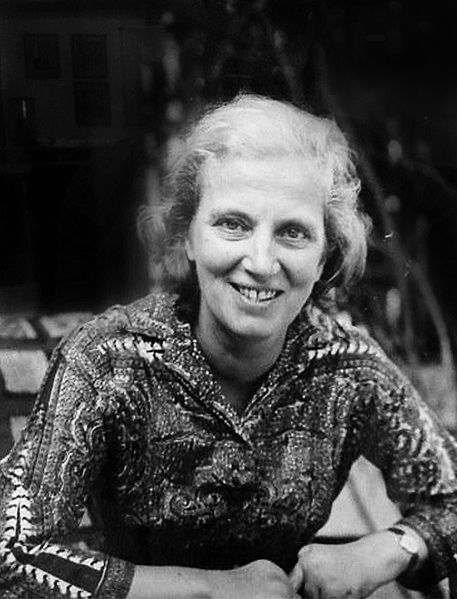
Dorothy Mary Hodgkin OM, FRS (12 May 1910 – 29 July 1994), née Crowfoot, was a British chemist, credited with the development of protein crystallography.
She advanced the technique of X-ray crystallography,
a method used to determine the three dimensional structures of
biomolecules. Among her most influential discoveries are the
confirmation of the structure of penicillin that Ernst Boris Chain had previously surmised, and then the structure of vitamin B12, for which she was awarded the Nobel Prize in Chemistry. In 1969, after 35 years of work and five years after winning the Nobel Prize, Hodgkin was able to decipher the structure of insulin.
X-ray crystallography became a widely used tool and was critical in
later determining the structures of many biological molecules such as DNA where
knowledge of structure is critical to an understanding of function. She
is regarded as one of the pioneer scientists in the field of X-ray
crystallography studies of biomolecules. Dorothy Mary Crowfoot was born on 12 May 1910 in Cairo,
Egypt, to John Winter Crowfoot (1873 – 1959), excavator and scholar of
classics, and Grace Mary Hood (1877 – 1957). For the first four years
of her life she lived as an English expatriate in Asia Minor, returning to England only a few months each year. She spent the period of World War I in
the UK under the care of relatives and friends, but separated from her
parents. After the war, her mother decided to stay home in England and
educate her children, a period that Hodgkin later described as the
happiest in her life. In 1921, she entered the Sir John Leman Grammar School in Beccles, England. She travelled abroad frequently to visit her parents in Cairo and Khartoum. Both her father and her mother had a strong influence with their Puritan ethic
of selflessness and service to humanity which reverberated in her later
achievements. She also helped scientists all over the world fight diabetes, a common disease that effects over 15 million Americans. Diabetics bodies' are unable to process sugar, also known as blood glucose, efficiently. Diabetes can be fatal. Due to Dr. Hodgkin's discovery, she has saved thousands of lives. She
developed a passion for chemistry from a young age, and her mother
fostered her interest in science in general. Her excellent early
education prepared her well for university. At age 18 she started
studying chemistry at Somerville College, Oxford, then one of the University of Oxford colleges for women only. She also studied at the University of Cambridge under the tutelage of John Desmond Bernal, where she became aware of the potential of X-ray crystallography to determine the structure of proteins. In
1934, she moved back to Oxford and two years later, in 1936, she became
a research fellow at Somerville College, a post which she held until
1977. In the 1940s, one of her students was future Prime Minister Margaret Thatcher, who installed a portrait of Hodgkin in Downing Street in the 1980s. Together with Sydney Brenner, Jack Dunitz, Leslie Orgel, and Beryl Oughton, she was one of the first people in April 1953 to see the model of the structure of DNA, constructed by Francis Crick and James Watson;
at the time he and the other scientists were working at Cambridge
University's Cavendish Laboratory. All were impressed by the new DNA
model, especially Brenner who subsequently worked with Crick. In 1960 she was appointed Wolfson Research Professor at the Royal Society.
Insulin was
one of her most extraordinary research projects. It began in 1934 when
she was offered a small sample of crystalline insulin by Robert Robinson. The hormone captured
her imagination because of the intricate and wide ranging effect it has
in the body. However, at this stage X-ray crystallography had not been
developed far enough to cope with the complexity of the insulin
molecule. She and others spent many years improving the technique.
Larger and more complex molecules were being tackled until in 1969 – 35 years later - the structure of insulin was
finally resolved. But her quest was not finished then. She cooperated
with other laboratories active in insulin research, gave advice, and
travelled the world giving talks about insulin and its importance for diabetes. Hodgkin's scientific mentor Professor John Desmond Bernal greatly
influenced her life both scientifically and politically. He was a
distinguished scientist of great repute in the scientific world, a
member of the Communist party, and a faithful supporter of successive Soviet regimes until their invasion of Hungary.
She always referred to him as "Sage"; intermittently, they were lovers.
The conventional marriages of both Bernal and Hodgkin were far from
smooth. In 1937, Dorothy married Thomas Lionel Hodgkin, then recently returned from working for the Colonial Office and moving into adult education. He later became a well-known Oxford Lecturer, author of several fundamental Africanist books and a one-time member of the Communist party. She always consulted him concerning important problems and decisions. In 1961 Thomas became an advisor to Kwame Nkrumah, President of Ghana,
where he remained for extended periods, and where she often visited
him. The couple had three children. Because of her political activity
and her husband's association with the Communist Party, she was not
allowed to enter the US except by CIA waiver until the end of her life
(after the collapse of the Soviet Union). They had three children Luke, born in 1938, Elizabeth, born in 1941 and Toby, born in 1946.
Despite her scientific specialisation and excellence she was by no means a single minded and
one sided scientist. She received many honours but was more interested
in exchange with other scientists. She often employed her intelligence
to think about other people's problems and was concerned about social inequalities and stopping conflict. As a consequence she was President of Pugwash from 1976 to 1988. Apart from the Nobel Prize, she was a recipient of the Order of Merit, a recipient of the Copley Medal, a Fellow of the Royal Society, The Lenin Peace Prize, and was Chancellor of Bristol University from 1970 to 1988. Council offices in the London Borough of Hackney and buildings at Bristol University and Keele University are named after her. Dorothy Hodgkin was one of five 'Women of Achievement' selected for a set of
British stamps issued in August 1996. The others were Marea Hartman (sports administrator), Margot Fonteyn (ballerina/choreographer), Elisabeth Frink (sculptor) & Daphne du Maurier (writer). All except Hodgkin were Dames Commander of the Order of the British Empire (DBEs).
